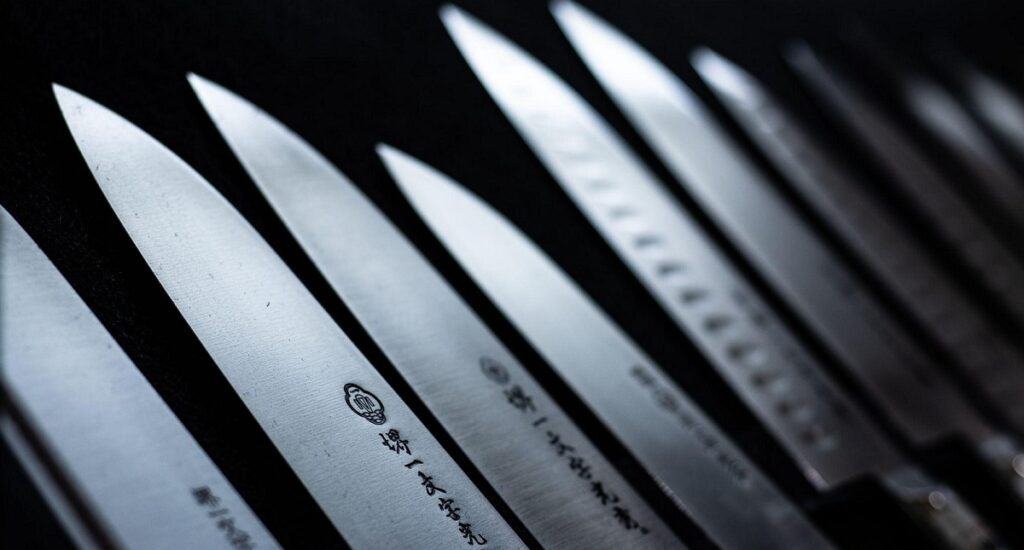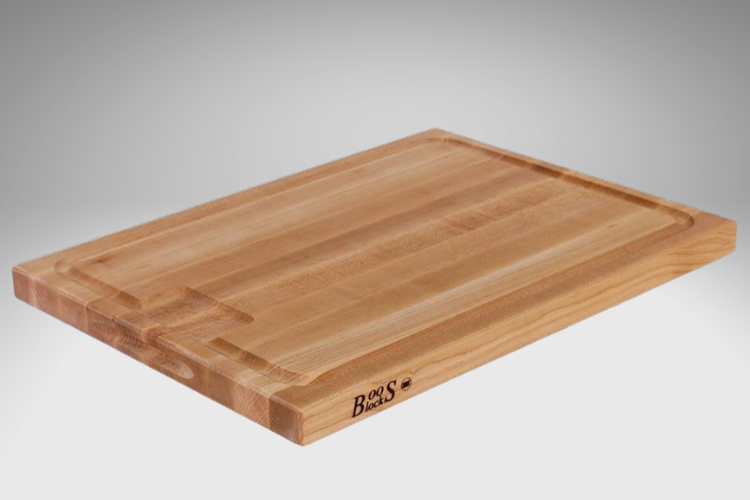While German vs. Japanese knives share some similarities. The two have some key differences, such as high-quality materials and expert craftsmanship.
German knives are known for their strength, durability and weight. At the same time, Japanese knives are known for their sharpness, precision, and agility.
The blade shapes and angles are also different, with German knives typically having a thicker blade and a wider angle, while Japanese knives have a thinner blade and a more acute angle.
Ultimately, the choice between German and Japanese knives comes from personal preference and the user’s specific needs.
Of course, deciding between a German knife and a Japanese-style knife is not always easy. There are many things to consider first, so you must research and know precisely what the primary needs in your kitchen are. Let’s go deeper into the difference between German and Japanese knives.
Unlock a world of culinary mastery with the Wusthof Classic 15-Piece Knife Block Set – the secret ingredient to elevate your cooking. Are you ready to become a kitchen superstar?
German vs. Japanese Knife: Steel Similarities
When we talk about Japanese knives vs. German knives, we mainly refer to Western knives, either German or Japanese. These knives do not strictly follow the traditions of their place of origin. Instead, they are inspired by them.
While the most popular brands tend to manufacture their knives in Japan and Germany, respectively, they create their products by focusing on a more international audience.
That means that they do not just focus solely on the dietary practices of the Japanese and German people.
Today, most knife-maker brands tend to create knives that blend different techniques of knife manufacturing to create products that meet the needs of a wider audience.
Most modern knives are crafted in such ways so they can have a greater utility span. Moreover, many German brands also include Japanese-style knives and vice versa.
(also see How to Use Your Japanese Steak Knives Like a Pro)
This global demand has led to many different-style knives having more similarities than differences. For example, a Western-style Japanese knife resembles a regular chef’s knife made by German brands.
Moreover, unlike the traditional Japanese knives honed only on one side of the blade (single bevel), Japanese-style knives are sharpened from both sides (double bevel).
Much like most Western knives, including German-style knives.
Have you ever wondered how professional chefs create masterpieces in the kitchen? Unveil their secret weapon – the Wusthof Classic 15-Piece Knife Block Set. It’s time to unleash your inner chef and take your cooking skills to the next level. Ready to join the ranks of culinary geniuses?
German Steel vs. Stainless Steel Differences
Of course, besides their similarities, they still differ in many ways regarding the function they serve, the technique used to create them, and how they are used in the kitchen.
Functions & Metals
In terms of function, a Japanese-style knife tends to be extremely sharp. They are great for slicing or dicing vegetables, fruits, and fish. They can be easily cut precisely through several different types of food.
Japanese knives are usually made with carbon steel, which makes them harder. The more tough a blade is, the more vulnerable it is to chipping or bending.
However, their distinctive sharpness is because they are made with carbon steel and the fact that they are usually hand-refined. Their blades are also thinner and straighter, allowing sharp edges for more precision.
The main advantage of a German kitchen knife is that it tends to be durable and last longer. A common type of steel used efficiently to make this knife is stainless steel. The moreover-purpose tool can be great for slicing, chopping, cutting, etc.
The reason behind its great versatility is that it is so durable. It can easily cut through more dense types of food like meat.
A German kitchen knife is made with softer steel, which is responsible for its durability. It is also more corrosion-resistant, as rust is the most significant challenge for knife users.
Unlike Japanese knives, German blades are usually refined with a machine. Their blades are also curved to allow the cutting of bigger chunks of dense types of food.
Based on the industry-standard Rockwell scale that tests a steel’s hardness, the metal used for a kitchen knife should be between 58-62 HRC. German knives use metals that, on average, are around 58 but are mainly lower. Metals like carbon metal make Japanese knives score closer to 60 and 61.
Blades & Handles
Traditionally, Japanese knives have the end of their blade attached to the handle. This gives the knife less weight, especially at the side of the handle.
Most of their weight is on the blade, which allows for better forward movements and more control by the user.
Unlike German knives, they also tend to have no bolster, the thick junction between the handle and the blade. Along with the type of steel used, this also factors into its general lightness in terms of its overall weight.
German knives typically have full-tang designs, meaning their blade continues well through the handle. The handle encloses the remaining steel in its center. This results in the knife having more weight and being sturdier.
(Need to read The Best Kitchen Knives for Every Task: Cut Above the Rest)
High Carbon Stainless Steel vs. German Stainless Steel
As mentioned above, there are many things to consider before purchasing. Most people value multi-purpose products more than products for specific uses.
Others want specialized tools for each task for ultimate and precise performance.
(Learn more about 9 Best Damascus Kitchen Knives: 2023 Review and Buying Guide)
Indeed, people who consider themselves culinary experts prefer a more comprehensive collection of kitchen knives and invest in them as they seek a multi-functional cooking experience.
They also tend to be willing to invest their time in the appropriate effort to maintain their equipment’s top form.
No matter what you choose, there are a lot of brands that offer high-quality knives of both styles.
For German-style knives, Wüsthof, Zwilling, Messermeister, Güde, Mercer, and others, are some of the best brands that can provide you with durable kitchen tools, and they will last you for many years.
For Japanese-style knives, Yoshihiro, Shun, Sakai Takayuki, Global, Miyabi, and more, are great brands that explicitly produce knives with straight blades.
(Find out What Is the Best Knife for Cutting Meat – What to Consider)
With the global market continuously expanding to include more groups of people of various backgrounds, the target audience’s needs keep changing. For that reason, knife manufacturers must develop new products that serve a wider group of customers, each with different expectations.
The good thing is that most companies today offer both the German and the Japanese styles, and most importantly, they offer knives with blended styles. By experimenting with their manufacturing processes, famous knife brands can create kitchen tools that bring advantages from various knife styles.
What Are the Pros & Cons?
Pros
If you are looking for a knife with a very sharp edge, then a Japanese knife is exactly what you want. Japanese-style knives are explicitly designed to be the sharpest blades in your household. They are great for slicing your food precisely and allow for a clean release.
They are perfect for cutting materials such as vegetables, fish, and other seafood. Moreover, if you hone them, these knives retain their sharp edges longer than others.
German knives are well-known for their durability. They tend to last a long time for most users, and if they are taken care of, they can still be functional after decades.
Moreover, they do not require much effort for maintenance purposes. Thanks to their durability, they are also rust-resistant.
Price-wise, a German knife does not cost too much. Most knives have an average market price, and prices do not diverge much depending on your chosen brand.
Furthermore, the fact that German knives can be used in many ways makes them an excellent investment for a household.
Picture effortlessly slicing through ingredients with the Wusthof Classic 15-Piece Knife Block Set. Discover how you’ll save time and create delicious meals for your family. Could this be the missing piece in your kitchen routine?
Cons
Unfortunately, the carbon steel that allows for the sharpness of Japanese knives makes them more brittle. You might easily bend or snap the top off without carefully using a Japanese kitchen knife. You must take extreme care of your knife to ensure it lasts long.
Therefore, a Japanese-style knife requires you to perform the necessary maintenance, such as appropriate cleaning and the occasional honing.
You must put more effort into using and maintaining your knife, so you cannot use it to cut anything.
For example, you need a more heavy-duty knife blade to cut through raw meat, so having a Japanese kitchen knife makes you have to purchase other types of knives, so you can do the tasks you cannot do with that. Depending on the brand.
Japanese kitchen knives also tend to be slightly pricier than German ones, which can be a deal-breaker for those on a budget.
German knives do not have great sharpness-retention, which means their sharp edges do not last long.
A German blade requires consistent honing as it can lose its cutting edge quickly due to its softer steel. Therefore, users must put more effort into regularly getting their knives back to form.
This can disadvantage users who do not have the time to hone their knives often and want to cook their meals quickly.
Give your loved one the gift of precision and elegance with the Wusthof Classic 15-Piece Knife Block Set. Watch their eyes light up as they unleash their inner chef. Who in your life deserves this ultimate kitchen upgrade?
Last Updated on December 16, 2023 by John Siracusa



